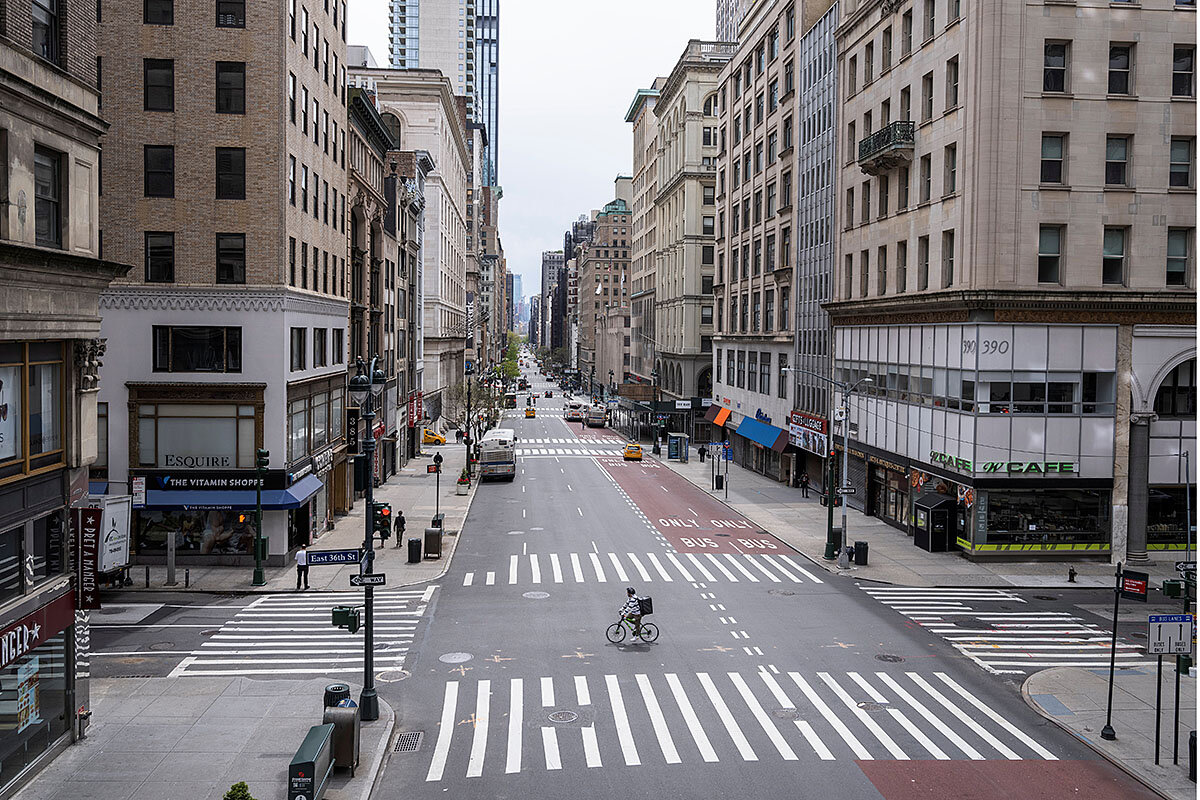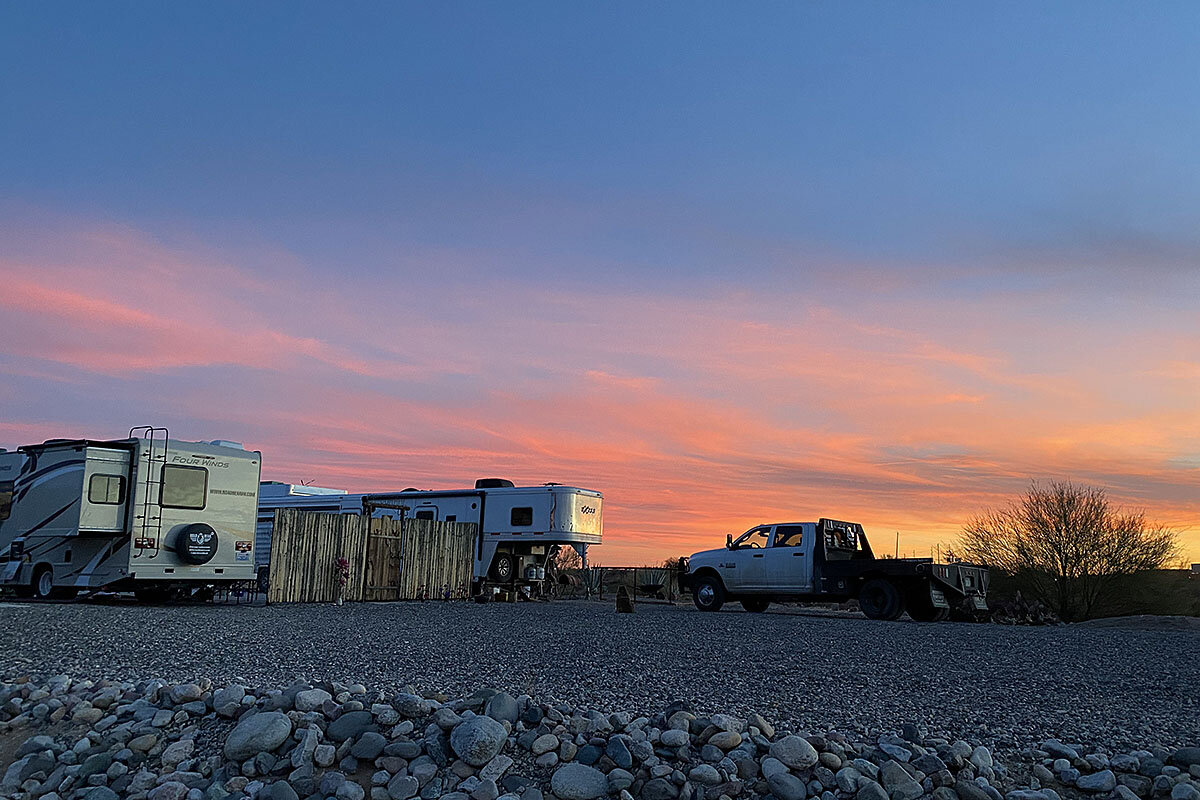Remote work is here to stay – and it’s changing our lives
Loading...
It might be the largest natural experiment in the history of work. This past year, instead of commuting in cars or by rail, a vast swath of the workforce has found that going to work can mean simply logging in from home. For business consultant Kenny D’Evelyn, it means visiting clients via Zoom rather than airplane trips.
Remote work has its challenges, for sure, but it’s been working well enough that experts see a permanent shift.
Why We Wrote This
What happens – to our jobs, organizations, communities – if the pandemic’s biggest business lesson has been to convince us that working from home is normal?
The market research firm Forrester predicts that, even after the pandemic fades, organizations overall will have 30% of workers entirely on site, 10% all-remote, and 60% in some hybrid mix. That’s a very long way from where we were a year ago.
The ripple effects range from shifts in where people choose to live to, perhaps, changes even in the social structure of their lives.
“Places change people,” says Joel Kotkin, a demography expert at Chapman University in Orange, California. And people change places. “I think we’re going to see Americans reinvent themselves, as they’ve always done, as villagers. ... Their attention will be on their local communities in ways it wasn’t when they left that community every day for work.”
It’s a typical January morning somewhere in the desert outside Wickenburg, Arizona, and corporate strategy consultant Kenny D’Evelyn is heading for work. He kisses his wife goodbye, steps out of his 26-foot RV with the truck cab in front, squints into the still-rising sun, and walks 14 paces to a shiny aluminum horse trailer. He opens the door, pulls a chair across some straw, and sits at a makeshift desk. He fires up a computer. And he prepares – for the first but by no means last time this day – to Zoom.
It was not always thus. Until a year ago Mr. D’Evelyn went to work like most of us did – more than most of us did, actually, given his consultant’s life of spending four days of every week at a client’s site on the road. But then last March he was sent home. At which point he became an involuntary part of what might be the largest natural experiment in the history of work.
Says California-based corporate event producer Kelly Klopp, “Overnight, we went from full time in the office to working from home.” As the show-runner for a scheduled three-day, 20,000-attendee conference set in Las Vegas, she suddenly had not just her own work habits to sort, but a whole enormous business problem to solve. (Upshot: she and her client pulled it off virtually.)
Why We Wrote This
What happens – to our jobs, organizations, communities – if the pandemic’s biggest business lesson has been to convince us that working from home is normal?
Remote work had been strongly increasing even before the pandemic, says demographer Wendell Cox – amounting to 5.3% of the workforce, three times its 2010 share. But by last May that number had ballooned to 42%, Stanford University reported – eight times pre-pandemic levels. And the homebound workers were liking it. An IBM poll found that 54% wanted to keep working from home post-pandemic, and 75% wanted the option of working from home occasionally.
“What the pandemic made blazingly obvious,” says a Manhattan entertainment lawyer, “is that there is no need for a physical office.” Only a complete lack of imagination, he says, kept the realization from dawning sooner. “Before the pandemic, we wouldn’t have taken the question [of going virtual] seriously. It wouldn’t have seemed possible.”
Mr. D’Evelyn wouldn’t have thought it possible, either. By January, though, he’d mastered the new remote-work drill: 5 to 7 hours of Zoom meetings a day, prep work early in the morning, follow-up work after dinner at night. Only thing is that in January, when he and his wife repaired for a month to a friend’s land in a rented RV, the day included horses. Up at 5:30, horses “grained and fed” by 6, an hour of reading, then ... ride. By 8:30, out of the saddle and back to the desk – but even seven hours of Zooming feel different when a day starts like that. “On the whole,” says Mr. D’Evelyn, “I’ve been ecstatic.”
And yet, “I’m very over working from home right now.” Live meetings used to energize him; Zoom meetings exhaust him. Work hours have expanded. “I’m not sure how sustainable it is.”
The entertainment lawyer, despite having discovered the functional “pointlessness” of the office, has nevertheless tired of home-working, too. “I hadn’t realized how much the social aspect of work was important to me. I miss my work family!”
So where has our massive work style experiment left us? Will we leave remote work behind as the pandemic ends, or perpetuate it, or craft it into something new?
Answer: It’s complicated. The pandemic has certainly sowed chaos on numerous economic levels – from supply-chain disruptions to job losses and an attendant worsening of economic inequalities. The rise of remote work is one shift that, while not necessarily helping all workers, is being greeted widely as positive and more than temporary.
The lasting impulse may be especially toward hybrid work modes, more than full-time work from home. But the growing detachment of jobs from geography is ushering in greater flexibility even as it tests and reshapes social bonds that so often have been forged at work in the past.
The rise of “Zoom towns”
“The most important outcome of the pandemic wasn’t that it taught you how to use Zoom, but rather that it forced everybody else to use Zoom,” MIT economist David Autor told The Atlantic. “We all leapfrogged over the coordination problem at the exact same time.”
It’s hard to find a management expert who doesn’t judge the work-from-home experiment a resounding – and somewhat unexpected – success. A survey by the recruiting firm Robert Walters found that 77% of professionals believe they’ve been equally or more effective when remote, and that 86% of employers plan to continue remote work “in some form” after the pandemic ends. A January survey by the consulting firm PwC revealed that employer satisfaction had risen even as the year dragged on, with 83% now assessing remote work successful for their company, up from 73% last June.
Wrote one top manager in an email posted by economist Tyler Cowen: “Speaking from personal experience as a white-collar Exec, the productivity gains for our highest value workers has been immense. The typical time-sucks and distractions of in-office work have been eliminated.... Mental focus on productive efforts is near constant. Perhaps most importantly, work travel is not happening.”
But is remote work just an anomaly suited to crisis, or will it last? To know, it helps to consider what workers, company managers, and investors each want – and what they’re already doing.
Executives, in particular, seem to have made up their minds. Fewer than 1 in 5, according to the PwC survey, say they want their organizations to return to the office as it was pre-pandemic. Among managers, more than 80% are “grappling with how widely to extend remote work options.” Meanwhile, companies including Twitter, Siemens, Shopify, Facebook, and State Bank of India have announced that they will make remote work permanent.
Some investors also appear sold. Among venture capitalists and venture-backed entrepreneurs, 74% now expect their companies to be majority or fully remote. And after venture-backed founders told surveyors before the pandemic that the “most beneficial location to start a company” was San Francisco, this year they answered that the best location was none (“distributed or remote”) – which received seven times the votes it scored a year earlier.
As for workers, Gallup recently found that they, too – Zoom-fatigue notwithstanding – would still rather work remotely than in their workplace, a preference they’re underscoring by voting with their feet, according to Joel Kotkin, a geographer who directs the Center for Demographics and Policy at Chapman University in Orange, California. “Even before the pandemic,” he says, “big cities like New York, Los Angeles, and Chicago were losing population to suburbs, lower-cost metro areas, and less expensive states in what Zillow called ‘a great reshuffling.’”
The trend has accelerated, Mr. Kotkin says. “In just the past six months, New York City lost almost as many residents as it gained since 1950.” He notes that a recent report by Upwork, a freelancing platform, suggests that 14 million to 23 million Americans are seeking to move to a less expensive and less crowded place. Welcome to the “Zoom towns.”
It may be that the remote-work phenomenon is an instance in which the incentives of workers, employers, and customers align. One example is the business model for the $241 billion management consulting industry in which Mr. D’Evelyn works.
For decades consultants would travel to client sites first thing Monday, work inside the client’s offices (and stay in nearby hotels and eat in nearby restaurants) until Thursday night, then travel home to spend Fridays in the consulting firm’s own building. All that client-site in-person work has been replaced by Zoom schedules like Mr. D’Evelyn’s, along with all that travel. And somewhat to the surprise of all parties, when the work shifted online, its quality didn’t change. “We discovered we can deliver the value without being there,” says Mr. D’Evelyn.
Suddenly, consultants were freed from the burnout-inducing road trips; employers saw their talent pool expand (the incessant travel had always driven consultants from the business as they grew older and had families); and customers got a discount due to avoided hotel and food bills. Win, win, win. When incentives align, change tends to stick – even though consultants will still spend some time on the road.
Still, the pandemic experiment has also uncovered ample drawbacks to remote work. Virtual teams function well when their members know each other and projects are already underway, but they’re not so good at launching new projects or convening strangers. As economist Dr. Cowen wrote last year, “Virtual [teams] simply can’t replicate the intellectual frisson of ‘gathering the smart people’ together, and this could damage performance and innovation.”
And then there’s the fact that remote work can be lonely, not least because remote workers are alone. Every worker who spoke with the Monitor admitted to exhaustion. This despite their universal conviction that telecommuting works, and that they wanted to keep doing it some of the time.
It’s that phrase “some of the time” that makes all the difference, experts increasingly say. Hence, the ascending idea of “hybrid” remote work – a work pattern mixing both office hours and home hours.
In surveys, both employees and leaders support it. According to PwC, over half of employees (55%) would prefer to be remote at least three days a week. Most executives (68%), on the other hand, say a typical employee should be in the office at least three days a week.
The market research firm Forrester predicts a 60-30-10 split among organizations: post-pandemic, 60% will be hybrid, 30% will be all-in-the-office, and 10% will be all-remote.
Which is a very long way from where we were a year ago.
A revival for social connections near home?
Experts can point to only one other work style “experiment” like the one caused by COVID-19, though its sample size in comparison was minuscule. When a 2011 earthquake demolished Christchurch, New Zealand, the entire community turned immediately to telework. Then the city rebuilt, renewing its stock of office space. Yet years later a study revealed that Christchurch’s workers continued to operate remotely, away from their freshly available workplaces. “When [the crisis] was over,” said a researcher, “they didn’t go back.”
If the expert consensus proves right, Americans won’t go back, either.
“As remote working has boomed during COVID-19,” summarizes a study by the University of Utah, “the rise in the number of people working from home has prompted many to reconsider where they wish to live.” Which means, as the survey data already indicate, that as many as 40% of office workers could scatter outward from the name-brand cities to places more spacious and affordable. Maybe some of the time even to an RV surrounded by mesquite and sky, as Mr. D’Evelyn did for a spell. Maybe to a place with horses.
A shift of workers to the periphery would be an economic boon to the places they go. The Zoom towns and suburbs and countryside would, under this scenario, profit from the migration of skilled jobs: Economists estimate that one skilled job generates 2.5 more jobs providing local goods and services. (Studies say tech workers generate an even higher multiple.)
Of course, working remotely will change not only where the work is done (and where people can live while doing it), but what work feels like, and what it can be relied on to provide in daily life. If people aren’t at the office, they’ll have to find alternative sources for the human interaction they used to find there.
The economist Robin Hanson writes, “As life at work [when remote] will be less social, people will have to get more of their socializing from elsewhere. So people will choose where they live more based on family, friends, leisure activities, and non-work social connections. Churches, clubs, and shared interest socializing will increase in importance. People will also pick where to live more based on climate, price, and views. Beach towns will boom, and the largest cities will lose.”
So workers will be more dispersed, and more of their working hours will be spent where they live instead of elsewhere in an office. The question is: Could all this lead to a “reset” of the locus of community in America?
Might the center of gravity shift at least somewhat from the office to the neighborhood – back, in a sense, to something closer to a pre-industrial model? What might it mean for our culture if the human contact that offices used to provide is replaced by closer-to-home human connections? And how might that affect the health of local communities and even levels of societal trust?
Mr. Kotkin, whose work has involved researching these dynamics for decades, answers by saying, “Places change people.” And people change places. “I think we’re going to see Americans reinvent themselves, as they’ve always done, as villagers,” he says. “I think they’re craving that. Their attention will be on their local communities in ways it wasn’t when they left that community every day for work. I think we’ll see more civic involvement. I think we’ll see new forms of local affiliation. We’re villagers, basically, because we thrive on human-scale environments, and interdependence; things feel different when you know you can rely on your neighbor for help.”
Here Mr. Kotkin quotes Lenin: “There are decades when nothing happens; and there are weeks when decades happen.”
Perhaps generations from now, he suggests, there will be historians who conclude that this pandemic year has been filled with such weeks – and that the world ahead of us will make plain the size of the change.












